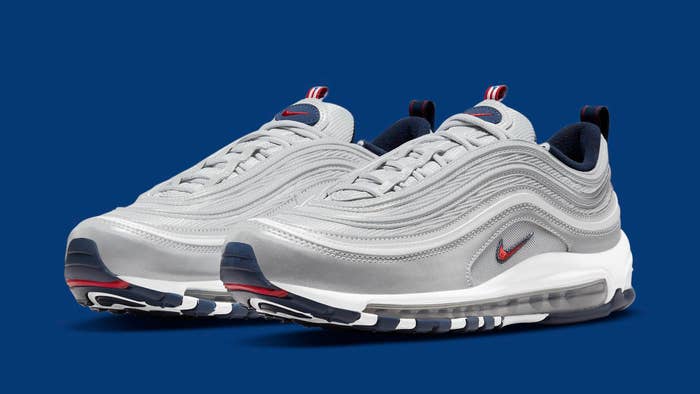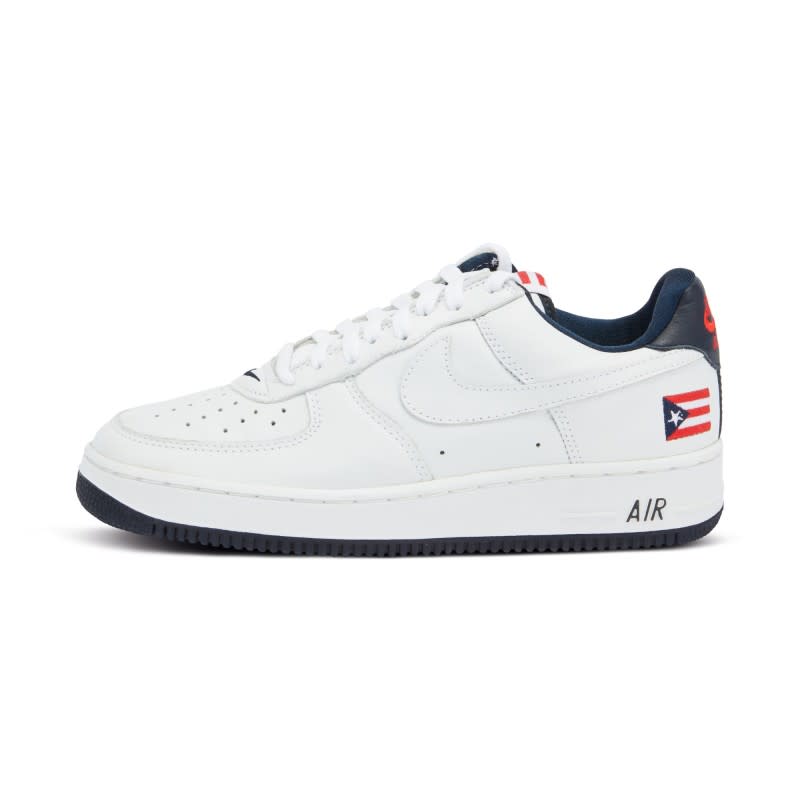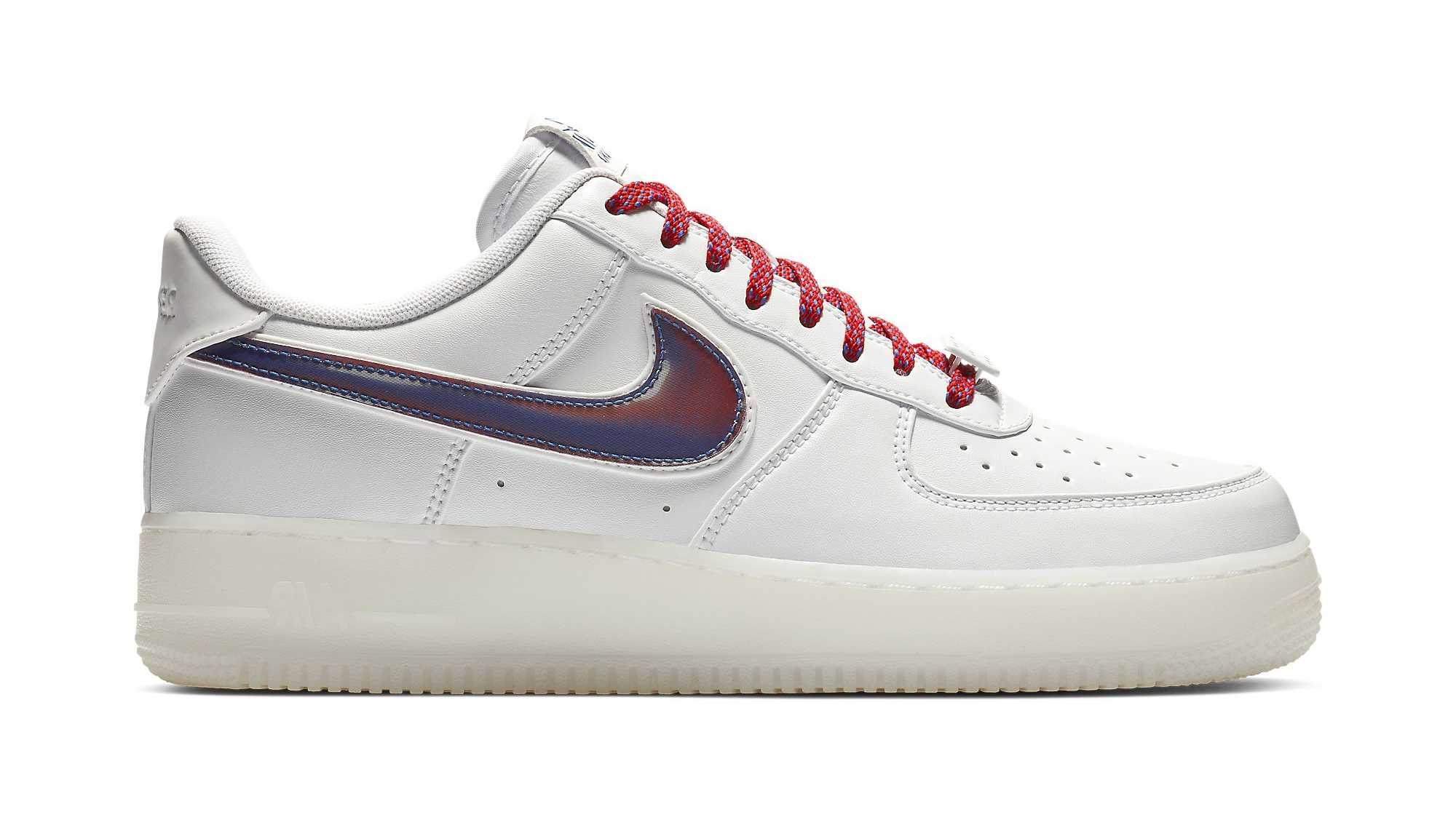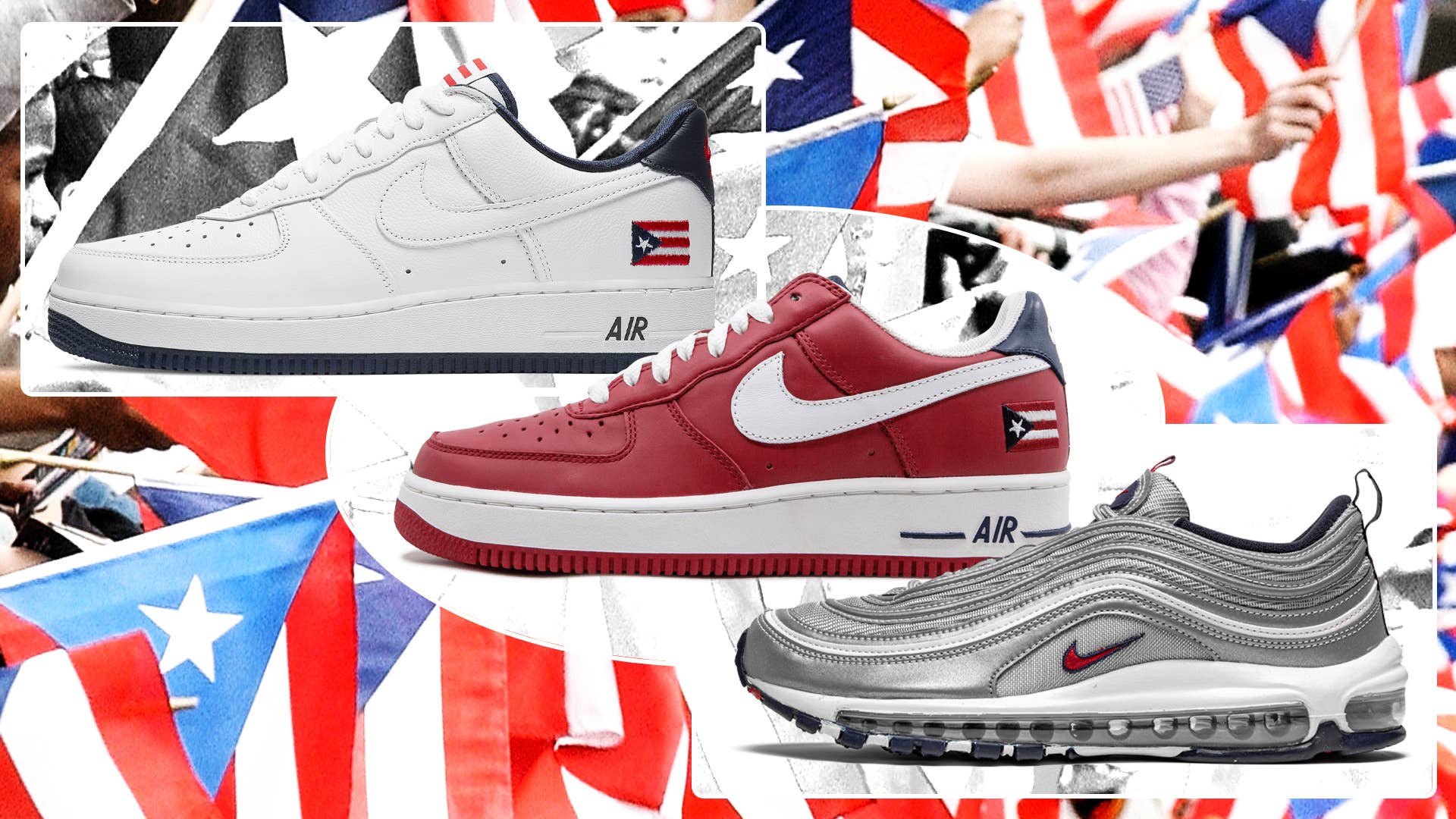
What does a sneaker corporation owe to the communities that support it? I don’t have the answer to that question, but Nike positions itself as a brand that cares, and I think—compared to other corporations and brands of their stature—they do a pretty good job.
New York City’s 64th annual Puerto Rican Day Parade happened this past weekend, and Nike released its latest sneaker dedicated to the United States territory. Instead of the traditional Air Force 1 low model traditionally used for its Puerto Rico tribute shoes, Nike decided to go a different route with an iteration of the “Silver Bullet” Air Max 97s by replacing the black accents with navy blue ones. There’s a PR flag at the top of the tongue and there’s also one on the bottom of the sole (still not sure how I feel about that). The saying “Aqui Me Quedo” (Here I’ll stay in Spanish) is plastered on the insoles and each pair comes with a towel that says “Puerto Rico, Te Quiero” (Puerto Rico, I love you). I am disappointed about there not being a coqui, the frog that’s indigenous to and a symbol of Puerto Rico, this time around, but there also isn’t any unfortunate Panamanian artwork or backward flags on the tongue, so I guess it evens out?

Since 2000, Nike has released several pairs of Air Force 1 lows with Puerto Rican flags and coquis adoring on them in various colorways, and Nuyoricans have been wearing them to the parade as if it were a tradition since they first dropped.
“That was a big, big deal. Everyone was talking about [Puerto Rico Air Force 1s]. If you were Puerto Rican, that was something you had to have no matter what. I remember that clearly, and going to the parade and wanting to have those sneakers and wanting to have your flag and wanting to walk up and down the streets,” La La Anthony said on an episode of Complex’s sneaker talk show Full Size Run from March.
I’ve always thought the sneakers were a cool nod to a population of people that helped make the AF1 silhouette as influential as it is. Puerto Rican culture (and West Indian culture in general) are a lifeblood of NYC street culture. The Carribean has been ingrained in hip hop from the very beginning with uptown—specifically the Bronx—being homebase for one of the largest Caribbean communities in the United States. Uptowns, as they are so affectionately called by NYC residents, were only used to play ball once upon a time, but when neighborhood kids started rockin’ them off the court as a show of flair, that’s when the Air Force 1 really became a cultural phenomenon.

The PR Forces are a significant chapter in the sneaker lifestyle department, but I’ll let a legend tell it. “I mean, listen, that shoe was a game-changer, bro,” Bobbito Garcia told me over the phone. “And I know that because I’ve consulted Mike Parker, who was the product line manager at the time. So, after that, the Caribbean Air Force 1 came out and logos on Nike that were not NBA-related started really popping. The starting point for all of that is the Puerto Rico Air Force 1. It’s a significant shoe in the history of the sneaker culture, the sneaker industry, you name it.”
Bobbito and Parker were childhood best friends who grew up together in the Westgate Houses on 97th Street, and Garcia remembered talking to him about the Puerto Rico Forces around 1999. “[Mike] had hit me up and was like, ‘Yo Bob, I want to put the Puerto Rican flag on the Air Force 1, a celebration of the parade.’” He continued, “And my initial reaction was like, ‘Yo, I don’t know if that’s a good move,’ and he was like, ‘What do you mean? I think people will be amped,’ and I was like, ‘Yeah, no, of course people will be amped, but you gotta understand, Puerto Rico has a very complex and layered relationship with the United States that dates back to 1898.’”
Puerto Rico has been colonized since 1493, when Christopher Columbus and his navy of savages landed on the shores of the Borikén (as the Tainos called the island). In 1898, the United States gained control of the island after they won the Spanish-American War and signed the Treaty of Paris. Since then there have been many efforts to become independent to no avail. The island is stuck in a perpetual limbo of independence and statehood as an unincorporated US territory. “In 1999, Vieques was still being bombed by the US Navy. We saw what happened with Hurricane Maria, the US’ disrespect of the island is still contemporary. It’s not something that happened 100 years ago,” says Garcia.
That’s a complex and layered relationship indeed. That’s why it’s so important to get these things right because the stakes are higher than slapping a flag on a sneaker.
A perfect example of how things can go wrong is the PR AF1 Nike that was set to release two years ago in 2019. For some odd reason, they slapped a Panamanian print called mola on the side panels. DJ Clark Kent, a longtime collector of Air Force 1s who’s worked with Nike over the years, called the design out on it on his Instagram, saying, “This is called a “Mola.” It is a Panamanian art form. You can find it anywhere in my home country, PANAMA. Respectfully, this is not a part of Puerto Rico’s rich culture. Though we are both Spanish speaking people, we have different traditions, art & cultural expressions. When celebrating one, please do proper research. These things should not be confused.”
Clearly Nike didn’t have actual people from the culture on that particular shoe. They then had another mix-up in 2020 but that one seems like it could’ve been a factory issue. Nike wanted to release the PR AF1 from 2000 to commemorate the shoe’s 20th anniversary, but the flag on the tongue was backwards, so they decided to recall the sneaker.
There are a couple of ways for Nike to keep Puerto Ricans satisfied as they continue to release different variations of PR sneakers. One way is to release a colorway representing the black and white resistance flag that has become the preferred flag for some Puerto Ricans. That’s a way for Nike to really show that they’re tapped in. Secondly, they can do as Garcia suggested to me when I talked to him. “I would like to see Nike use the sky blue color instead of the navy blue color, because when we look at the history of the flag, the original flag colors are sky blue, white, and red,” he offered.
Like Puerto Rico’s relationship with America is complicated, so is the island’s history with its flag. The first flag was made during El Grito de Lares, a failed coup attempt to overthrow Spanish rule in 1868. That flag had a cross separating sky blue panels at the top and red panels at the bottom with a white star in the upper left corner. Then, on Dec. 22, 1895, an inverted variant of the Cuban flag using the Grito de Lares colors was officially adopted by the Puerto Rican independence wing of the Cuban Revolutionary Party in New York City, hence why both flags resemble one another. While most Ricans recognize and use both the lighter and darker blue flags, the latter was made to reflect Puerto Rico’s affiliation with the United States. In order to suppress Puerto Rico’s independence movement, the US enacted the Law 53 of 1948, better known as the Gag Law. This law made it illegal to fly the Puerto Rican flag or to write, speak, or conspire in favor of independence. With America’s handling of Hurricane Maria and the controversial PROMESA Act President Obama signed in 2016, the island’s contentious history with the US is back in the spotlight.
Nike has done right for the most part when it comes to these sneakers, but they can always do more. “When I was the design director over the Air Forces, we would let the NYC team come with the ideas for it,” says Jessie Leyva, who served as Nike’s global design director and went onto run Nike Sportswear in the 2000s.
Dominican designer and NYC native Ceze P considers the PR AF1 a big inspiration for his De Me Lo Air Force 1s that dropped in 2018 and his recently released Air Max 95. “They definitely influenced my sneaker,” he says. “As a kid I saw the PR and West Indian ones and I always wondered why there wasn’t a Dominican version. So to finally get an opportunity to do that, it was really like a dream come true.”

Ceze’s variations of the AF1 and Air Max 95 are a bit flashier and have more Easter eggs than the PR ones. The Dominican AF1s are affectionately called the De Lo Mio AF1, as are the Air Max 95s. They both feature the saying, which translates to “my friend,” “my family,” or “my kin.” Little things like that are what make the Domincan Republic sneakers special. They’re made for the people that are supposed to wear them while also exposing Dominican culture to customers of other races, ethnicities, etc. “It’s a saying that’s uplifting,” Ceze tells me. “De lo mio is a New Age quote. I could’ve used ‘que lo que’ or ‘de me lo,’ but those are so stereotypical. It’s something we say when we see our people doing good, ‘Eso, de lo mio.’”
The Air Force 1s even have domino lace dubraes. His Air Max 95s were inspired by women and have even more Easter eggs. “The neon on the 95 is inspired by three things. Our policemen wear these neon vests and that was one of the things that inspired me. Literally, if you look it up, it’s the exact same neon and silver. So that was one. The plants in DR were another inspiration. I was in the mountains and I noticed when it rained a lot, the plants would get neon green and I had never really noticed that before. And the third thing… the sneaker was really inspired by women and the woman that really inspired the sneaker the most is Omahyra Mota. The supermodel from the ‘90s, early 2000’s and she had neon hair.”
Ceze’s rollout for both sneakers was special. I do feel, however, that the rollout for the 95s flew under the radar. He linked with the very talented photographer Renell Medrano, who of course is Dominican herself, and they shot the legend Omahyra Mota in their motherland. The De Lo Mio campaign should be the bar for every West Indian sneaker campaign moving forward. It showed Nike gives a fuck and they should be more consistent. Tap more people from the culture to help bring these sneakers new life. Puerto Ricans need more than just slapping a flag and a couple of sayings on some sneakers. Our colors and our flags mean more to us than you can ever imagine. I’ll end with a quote from New York Giants and Puerto Rock legend Victor Cruz on the 97s from the Complex Sneakers Podcast.
“I asked for two [pairs]. I got two on the way,” he said, explaining the significance of the shoe. I’m definitely about to fleece some of these secondary market brands for a couple more. I got to have at least four of five pairs of the Puerto Rico joints. It only makes sense.”

